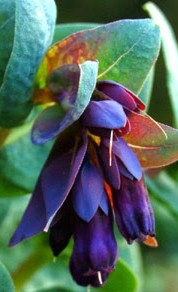 Also called honeywort and waxflower this annual or half hardy perennial is from the Mediterranean and does well in hot sunny conditions. It is in the borage family (Boraginaceae) along with heliotrope, comfrey and forget-me-not. It has attractive pewter-blue, leathery, spoon-shaped foliage and one inch long tubular purple-blue flowers borne in clusters of two to three and subtended with dark purple heart-shaped bracts. Plants tend to be self-sowing. The generic name Cerinthe comes from the Greek keros meaning wax, and anthos meaning flower. The flowers attract bees and the common names honeywort and waxflower arose from the belief that they were an important source of nectar and/or wax. A good choice for the border a container.The flowers are also good for cutting but their stems should be sealed with a flame or hot water.
Also called honeywort and waxflower this annual or half hardy perennial is from the Mediterranean and does well in hot sunny conditions. It is in the borage family (Boraginaceae) along with heliotrope, comfrey and forget-me-not. It has attractive pewter-blue, leathery, spoon-shaped foliage and one inch long tubular purple-blue flowers borne in clusters of two to three and subtended with dark purple heart-shaped bracts. Plants tend to be self-sowing. The generic name Cerinthe comes from the Greek keros meaning wax, and anthos meaning flower. The flowers attract bees and the common names honeywort and waxflower arose from the belief that they were an important source of nectar and/or wax. A good choice for the border a container.The flowers are also good for cutting but their stems should be sealed with a flame or hot water.
Type: Annual or half hardy perennial
Bloom: Once inch long purple-blue flowers with dark purple heart-shaped bracts during the summer
Size: 2’ H x 2” W
Light: Full sun to partial shade
Soil: Wide range of soils
Hardiness: Zones 7-10
Care: Low maintenance
Pests and Diseases: Slugs
Propagation: Seed (seed tends to be short lived so sow immediately after harvesting)
Companion plants: Crocosmia ‘Lucifer’, cape fuchsia (Phygelius x rectus) ‘Salmon Leap’, sedges Carex buchananii or Carex comans, spurge ( Euphorbia dulcis) ‘Chameleon’, chervil (Anthriscus sylvestris) “Ravenswing’, sweet amber aka tutsan (Hypericum andorosaemum) ‘Albury Purple’